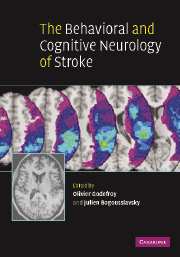Book contents
- Frontmatter
- Contents
- Contributors
- Preface
- 1 Evaluation of cognitive and behavioral disorders in the stroke unit
- Motor and gestural disorders
- Aphasia and arthric disorders
- Hemineglect, Anton–Babinski and right hemisphere syndromes
- 9 Hemispatial neglect
- 10 Anosognosia and denial after right hemisphere stroke
- 11 Asomatognosia
- 12 Disorders of visuoconstructive ability
- 13 Topographical disorientation
- Agnosia and Bálint's syndrome
- Executive and memory disorders
- Behavioral and mood disorders
- Dementia and anatomical left/right syndromes
- Index
- References
10 - Anosognosia and denial after right hemisphere stroke
Published online by Cambridge University Press: 10 October 2009
- Frontmatter
- Contents
- Contributors
- Preface
- 1 Evaluation of cognitive and behavioral disorders in the stroke unit
- Motor and gestural disorders
- Aphasia and arthric disorders
- Hemineglect, Anton–Babinski and right hemisphere syndromes
- 9 Hemispatial neglect
- 10 Anosognosia and denial after right hemisphere stroke
- 11 Asomatognosia
- 12 Disorders of visuoconstructive ability
- 13 Topographical disorientation
- Agnosia and Bálint's syndrome
- Executive and memory disorders
- Behavioral and mood disorders
- Dementia and anatomical left/right syndromes
- Index
- References
Summary
General presentation of anosognosia
Anosognosia is a puzzling condition. It refers to patients suffering from various neurological impairments who deny or lack awareness of their deficits, although these deficits may have serious consequences in their everyday life. Studying anosognosia is important for two reasons. The first one is a practical reason. Indeed, as pointed out by Heilman (1991), anosognosia is not a trivial problem. It may impair patients' motivation to engage in a rehabilitation program, and anosognosia has repeatedly been found associated with poor functional recovery from stroke. But studying anosognosia is also of great theoretical importance, as it may help our understanding of the complex relationships between brain injury and various forms of consciousness. However, despite this, anosognosia remains one of the least studied of the major neuropsychological symptoms after stroke, and its pathophysiology is still very poorly understood.
Detailed historical review of anosognosia have been published recently (Bisiach and Geminiani, 1991; Prigatano and Schacter, 1991). First observations of patients with impaired awareness of neurological deficits were reported in the late nineteenth century by von Monakow in 1885 and by Anton in 1889 in cases of cortical blindness. It seems that Pick, in 1898, was actually the first to report unawareness of left hemiplegia, but it was Joseph Babinski who first coined the term “anosognosia,” and his contribution, at a meeting held by the French Neurological Society on June 11, 1914, remains a landmark in the field (Babinski, 1914).
- Type
- Chapter
- Information
- The Behavioral and Cognitive Neurology of Stroke , pp. 198 - 214Publisher: Cambridge University PressPrint publication year: 2007
References
- 3
- Cited by



